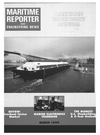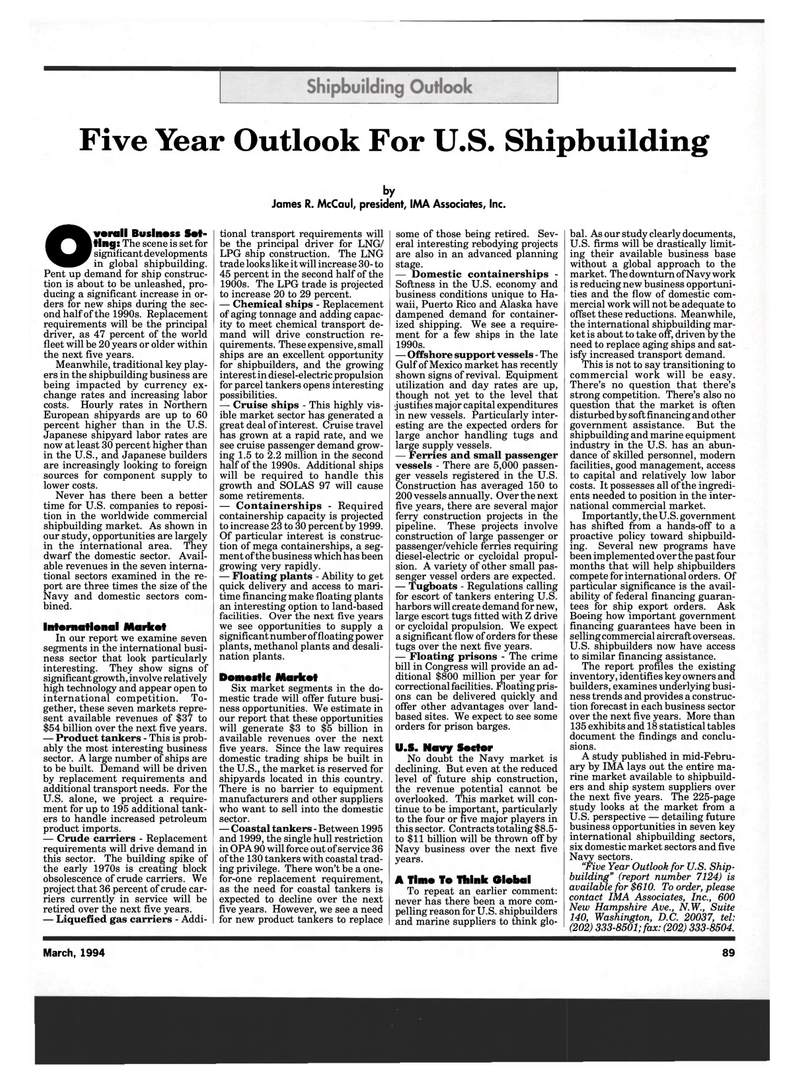
Page 87: of Maritime Reporter Magazine (March 1994)
Read this page in Pdf, Flash or Html5 edition of March 1994 Maritime Reporter Magazine
Five Year Outlook For U.S. Shipbuilding by
James R. McCaul, president, IMA Associates, Inc.
Overall Business Set-ting: The scene is set for significant developments in global shipbuilding.
Pent up demand for ship construc- tion is about to be unleashed, pro- ducing a significant increase in or- ders for new ships during the sec- ond half of the 1990s. Replacement requirements will be the principal driver, as 47 percent of the world fleet will be 20 years or older within the next five years.
Meanwhile, traditional key play- ers in the shipbuilding business are being impacted by currency ex- change rates and increasing labor costs. Hourly rates in Northern
European shipyards are up to 60 percent higher than in the U.S.
Japanese shipyard labor rates are now at least 30 percent higher than in the U.S., and Japanese builders are increasingly looking to foreign sources for component supply to lower costs.
Never has there been a better time for U.S. companies to reposi- tion in the worldwide commercial shipbuilding market. As shown in our study, opportunities are largely in the international area. They dwarf the domestic sector. Avail- able revenues in the seven interna- tional sectors examined in the re- port are three times the size of the
Navy and domestic sectors com- bined.
International Market
In our report we examine seven segments in the international busi- ness sector that look particularly interesting. They show signs of significant growth, involve relatively high technology and appear open to international competition. To- gether, these seven markets repre- sent available revenues of $37 to $54 billion over the next five years. — Product tankers - This is prob- ably the most interesting business sector. A large number of ships are to be built. Demand will be driven by replacement requirements and additional transport needs. For the
U.S. alone, we project a require- ment for up to 195 additional tank- ers to handle increased petroleum product imports. — Crude carriers - Replacement requirements will drive demand in this sector. The building spike of the early 1970s is creating block obsolescence of crude carriers. We project that 36 percent of crude car- riers currently in service will be retired over the next five years. — Liquefied gas carriers - Addi- tional transport requirements will be the principal driver for LNG/
LPG ship construction. The LNG trade looks like it will increase 30- to 45 percent in the second half of the 1900s. The LPG trade is projected to increase 20 to 29 percent. — Chemical ships - Replacement of aging tonnage and adding capac- ity to meet chemical transport de- mand will drive construction re- quirements. These expensive, small ships are an excellent opportunity for shipbuilders, and the growing interest in diesel-electric propulsion for parcel tankers opens interesting possibilities. — Cruise ships - This highly vis- ible market sector has generated a great deal of interest. Cruise travel has grown at a rapid rate, and we see cruise passenger demand grow- ing 1.5 to 2.2 million in the second half of the 1990s. Additional ships will be required to handle this growth and SOLAS 97 will cause some retirements. — Containerships - Required containership capacity is projected to increase 23 to 30 percent by 1999.
Of particular interest is construc- tion of mega containerships, a seg- ment of the business which has been growing very rapidly. — Floating plants - Ability to get quick delivery and access to mari- time financing make floating plants an interesting option to land-based facilities. Over the next five years we see opportunities to supply a significant number of floating power plants, methanol plants and desali- nation plants.
Domestic Market
Six market segments in the do- mestic trade will offer future busi- ness opportunities. We estimate in our report that these opportunities will generate $3 to $5 billion in available revenues over the next five years. Since the law requires domestic trading ships be built in the U.S., the market is reserved for shipyards located in this country.
There is no barrier to equipment manufacturers and other suppliers who want to sell into the domestic sector. — Coastal tankers - Between 1995 and 1999, the single hull restriction in OPA 90 will force out of service 36 of the 130 tankers with coastal trad- ing privilege. There won't be a one- for-one replacement requirement, as the need for coastal tankers is expected to decline over the next five years. However, we see a need for new product tankers to replace some of those being retired. Sev- eral interesting rebodying projects are also in an advanced planning stage. — Domestic containerships -
Softness in the U.S. economy and business conditions unique to Ha- waii, Puerto Rico and Alaska have dampened demand for container- ized shipping. We see a require- ment for a few ships in the late 1990s. — Offshore support vessels - The
Gulf of Mexico market has recently shown signs of revival. Equipment utilization and day rates are up, though not yet to the level that justifies major capital expenditures in new vessels. Particularly inter- esting are the expected orders for large anchor handling tugs and large supply vessels. — Ferries and small passenger vessels - There are 5,000 passen- ger vessels registered in the U.S.
Construction has averaged 150 to 200 vessels annually. Over the next five years, there are several major ferry construction projects in the pipeline. These projects involve construction of large passenger or passenger/vehicle ferries requiring diesel-electric or cycloidal propul- sion. A variety of other small pas- senger vessel orders are expected. — Tugboats - Regulations calling for escort of tankers entering U.S. harbors will create demand for new, large escort tugs fitted with Z drive or cycloidal propulsion. We expect a significant flow of orders for these tugs over the next five years. — Floating prisons - The crime bill in Congress will provide an ad- ditional $800 million per year for correctional facilities. Floatingpris- ons can be delivered quickly and offer other advantages over land- based sites. We expect to see some orders for prison barges.
U.S. Navy Sector
No doubt the Navy market is declining. But even at the reduced level of future ship construction, the revenue potential cannot be overlooked. This market will con- tinue to be important, particularly to the four or five major players in this sector. Contracts totaling $8.5- to $11 billion will be thrown off by
Navy business over the next five years.
A Time To Think Global
To repeat an earlier comment: never has there been a more com- pelling reason for U.S. shipbuilders and marine suppliers to think glo- bal. As our study clearly documents,
U.S. firms will be drastically limit- ing their available business base without a global approach to the market. The downturn of Navy work is reducing new business opportuni- ties and the flow of domestic com- mercial work will not be adequate to offset these reductions. Meanwhile, the international shipbuilding mar- ket is about to take off, driven by the need to replace aging ships and sat- isfy increased transport demand.
This is not to say transitioning to commercial work will be easy.
There's no question that there's strong competition. There's also no question that the market is often disturbed by soft financing and other government assistance. But the shipbuilding and marine equipment industry in the U.S. has an abun- dance of skilled personnel, modern facilities, good management, access to capital and relatively low labor costs. It possesses all of the ingredi- ents needed to position in the inter- national commercial market.
Importantly, the U.S. government has shifted from a hands-off to a proactive policy toward shipbuild- ing. Several new programs have been implemented over the past four months that will help shipbuilders compete for international orders. Of particular significance is the avail- ability of federal financing guaran- tees for ship export orders. Ask
Boeing how important government financing guarantees have been in selling commercial aircraft overseas.
U.S. shipbuilders now have access to similar financing assistance.
The report profiles the existing inventory, identifies key owners and builders, examines underlying busi- ness trends and provides a construc- tion forecast in each business sector over the next five years. More than 135 exhibits and 18 statistical tables document the findings and conclu- sions.
A study published in mid-Febru- ary by IMA lays out the entire ma- rine market available to shipbuild- ers and ship system suppliers over the next five years. The 225-page study looks at the market from a
U.S. perspective — detailing future business opportunities in seven key international shipbuilding sectors, six domestic market sectors and five
Navy sectors. "Five Year Outlook for U.S. Ship- building" (report number 7124) is available for $610. To order, please contact IMA Associates, Inc., 600
New Hampshire Ave., N.W., Suite 140, Washington, D.C. 20037, tel: (202) 333-8501; fax: (202) 333-8504.
March, 1994 89

 86
86

 88
88
